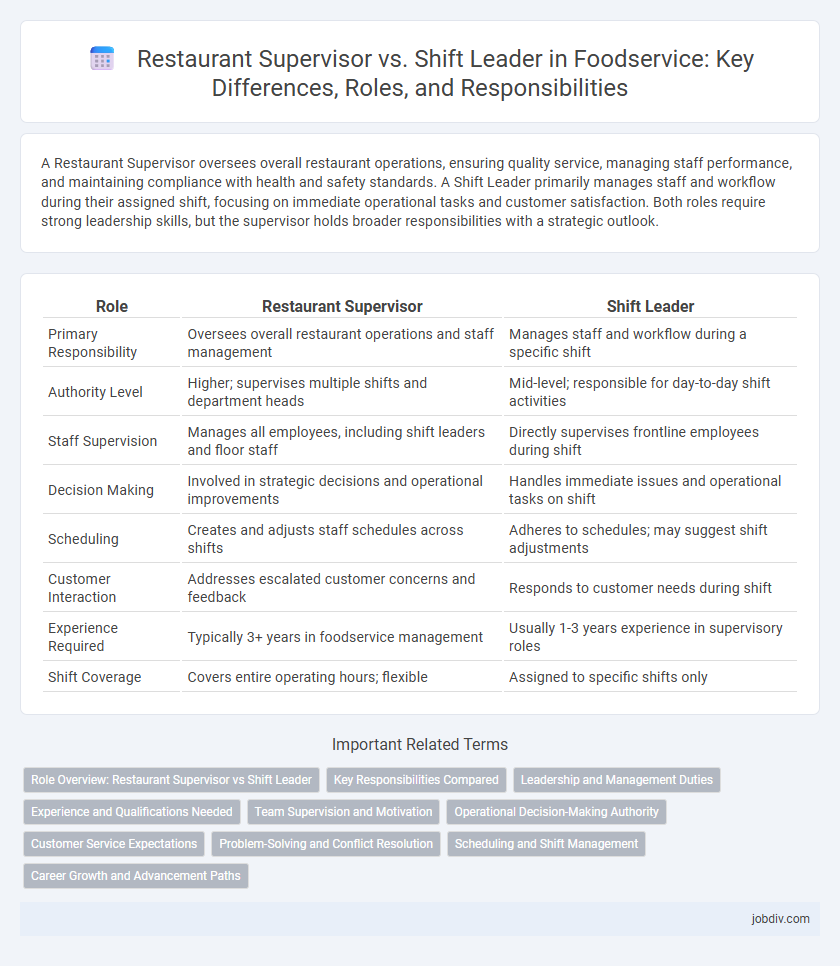A Restaurant Supervisor oversees overall restaurant operations, ensuring quality service, managing staff performance, and maintaining compliance with health and safety standards. A Shift Leader primarily manages staff and workflow during their assigned shift, focusing on immediate operational tasks and customer satisfaction. Both roles require strong leadership skills, but the supervisor holds broader responsibilities with a strategic outlook.
Table of Comparison
| Role | Restaurant Supervisor | Shift Leader |
|---|---|---|
| Primary Responsibility | Oversees overall restaurant operations and staff management | Manages staff and workflow during a specific shift |
| Authority Level | Higher; supervises multiple shifts and department heads | Mid-level; responsible for day-to-day shift activities |
| Staff Supervision | Manages all employees, including shift leaders and floor staff | Directly supervises frontline employees during shift |
| Decision Making | Involved in strategic decisions and operational improvements | Handles immediate issues and operational tasks on shift |
| Scheduling | Creates and adjusts staff schedules across shifts | Adheres to schedules; may suggest shift adjustments |
| Customer Interaction | Addresses escalated customer concerns and feedback | Responds to customer needs during shift |
| Experience Required | Typically 3+ years in foodservice management | Usually 1-3 years experience in supervisory roles |
| Shift Coverage | Covers entire operating hours; flexible | Assigned to specific shifts only |
Role Overview: Restaurant Supervisor vs Shift Leader
A Restaurant Supervisor oversees daily operations, staff performance, and customer satisfaction, ensuring smooth workflow and compliance with health regulations. A Shift Leader manages specific shift activities, coordinates team tasks, and addresses immediate employee concerns to maintain efficiency. Both roles require leadership and communication skills but differ in scope, with supervisors having broader managerial responsibilities.
Key Responsibilities Compared
Restaurant Supervisors oversee overall restaurant operations, ensuring quality service, staff management, and compliance with health and safety standards. Shift Leaders focus on managing daily shift activities, such as coordinating team tasks, handling customer issues, and maintaining workflow efficiency. While Supervisors have broader managerial duties, Shift Leaders emphasize operational leadership during specific shifts.
Leadership and Management Duties
A Restaurant Supervisor oversees overall restaurant operations, focusing on staff training, inventory management, and ensuring compliance with health and safety regulations. Shift Leaders manage daily operational tasks during their shift, including delegating duties, handling customer service issues, and monitoring team performance on the floor. While both roles require leadership, Supervisors have broader management responsibilities and strategic oversight, whereas Shift Leaders focus on immediate operational execution and team coordination.
Experience and Qualifications Needed
Restaurant supervisors typically require extensive experience in foodservice management, often five or more years, with strong skills in team leadership, inventory control, and customer service. Shift leaders usually need 1 to 3 years of experience in restaurant operations, demonstrating competence in coordinating daily staff activities, handling customer inquiries, and maintaining quality standards. Qualifications for supervisors often include certifications in food safety and management training, whereas shift leaders may only require basic food handler certifications and on-the-job experience.
Team Supervision and Motivation
Restaurant Supervisors manage overall team performance and workflow, ensuring service standards are consistently met through effective delegation and oversight. Shift Leaders focus on direct team supervision during specific shifts, motivating staff in real-time to maintain productivity and customer satisfaction. Both roles require strong communication and leadership skills to foster a positive, efficient work environment.
Operational Decision-Making Authority
Restaurant Supervisors possess higher operational decision-making authority compared to Shift Leaders, overseeing multiple shifts and managing overall restaurant performance. Shift Leaders primarily handle real-time operational decisions during their assigned shifts, focusing on staff coordination and customer service. The Supervisor's role includes strategic planning and resource allocation, ensuring compliance with company policies and optimizing daily operations.
Customer Service Expectations
Restaurant supervisors oversee overall service quality, ensuring customer satisfaction through effective team management and problem resolution. Shift leaders focus on real-time customer interactions, directly addressing guest needs and maintaining service standards during their shifts. Both roles emphasize timely communication, attentiveness, and efficient handling of customer complaints to uphold a positive dining experience.
Problem-Solving and Conflict Resolution
Restaurant supervisors manage overall operations with a strategic approach to problem-solving, ensuring efficient workflow and customer satisfaction. Shift leaders focus on immediate issue resolution within their shifts, directly addressing team conflicts and operational disruptions to maintain smooth service. Both roles require strong communication skills, but supervisors engage in proactive conflict management while shift leaders handle reactive, on-the-spot challenges.
Scheduling and Shift Management
Restaurant Supervisors oversee overall scheduling, ensuring optimal staff coverage and balancing workload across shifts to maintain service quality. Shift Leaders focus on real-time shift management, coordinating team tasks and addressing immediate operational challenges to ensure smooth restaurant functioning. Effective scheduling by supervisors combined with proactive shift leadership enhances productivity and customer satisfaction in foodservice environments.
Career Growth and Advancement Paths
Restaurant supervisors typically oversee multiple shifts and have broader managerial responsibilities, positioning them for higher-level roles such as restaurant manager or operations manager. Shift leaders focus on direct floor supervision during a specific shift, gaining hands-on experience in team leadership and customer service that serves as a foundation for advancing to supervisor roles. Career growth in foodservice favors those who develop strong leadership skills, operational knowledge, and the ability to manage diverse teams effectively.
Restaurant Supervisor vs Shift Leader Infographic

 jobdiv.com
jobdiv.com